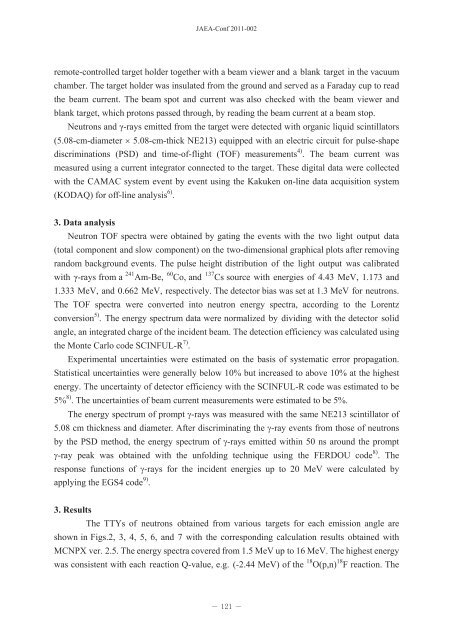JAEA-Conf 2011-002 - 日本原子力研究開発機構
JAEA-Conf 2011-002 - 日本原子力研究開発機構
JAEA-Conf 2011-002 - 日本原子力研究開発機構
You also want an ePaper? Increase the reach of your titles
YUMPU automatically turns print PDFs into web optimized ePapers that Google loves.
<strong>JAEA</strong>-<strong>Conf</strong> <strong>2011</strong>-<strong>002</strong><br />
remote-controlled target holder together with a beam viewer and a blank target in the vacuum<br />
chamber. The target holder was insulated from the ground and served as a Faraday cup to read<br />
the beam current. The beam spot and current was also checked with the beam viewer and<br />
blank target, which protons passed through, by reading the beam current at a beam stop.<br />
Neutrons and -rays emitted from the target were detected with organic liquid scintillators<br />
(5.08-cm-diameter 5.08-cm-thick NE213) equipped with an electric circuit for pulse-shape<br />
discriminations (PSD) and time-of-flight (TOF) measurements 4) . The beam current was<br />
measured using a current integrator connected to the target. These digital data were collected<br />
with the CAMAC system event by event using the Kakuken on-line data acquisition system<br />
(KODAQ) for off-line analysis 6) .<br />
<br />
Neutron TOF spectra were obtained by gating the events with the two light output data<br />
(total component and slow component) on the two-dimensional graphical plots after removing<br />
random background events. The pulse height distribution of the light output was calibrated<br />
with -rays from a 241 Am-Be, 60 Co, and 137 Cs source with energies of 4.43 MeV, 1.173 and<br />
1.333 MeV, and 0.662 MeV, respectively. The detector bias was set at 1.3 MeV for neutrons.<br />
The TOF spectra were converted into neutron energy spectra, according to the Lorentz<br />
conversion 5) . The energy spectrum data were normalized by dividing with the detector solid<br />
angle, an integrated charge of the incident beam. The detection efficiency was calculated using<br />
the Monte Carlo code SCINFUL-R 7) .<br />
Experimental uncertainties were estimated on the basis of systematic error propagation.<br />
Statistical uncertainties were generally below 10% but increased to above 10% at the highest<br />
energy. The uncertainty of detector efficiency with the SCINFUL-R code was estimated to be<br />
5% 8) . The uncertainties of beam current measurements were estimated to be 5%.<br />
The energy spectrum of prompt -rays was measured with the same NE213 scintillator of<br />
5.08 cm thickness and diameter. After discriminating the -ray events from those of neutrons<br />
by the PSD method, the energy spectrum of -rays emitted within 50 ns around the prompt<br />
-ray peak was obtained with the unfolding technique using the FERDOU code 8) . The<br />
response functions of -rays for the incident energies up to 20 MeV were calculated by<br />
applying the EGS4 code 9) .<br />
<br />
The TTYs of neutrons obtained from various targets for each emission angle are<br />
shown in Figs.2, 3, 4, 5, 6, and 7 with the corresponding calculation results obtained with<br />
MCNPX ver. 2.5. The energy spectra covered from 1.5 MeV up to 16 MeV. The highest energy<br />
was consistent with each reaction Q-value, e.g. (-2.44 MeV) of the 18 O(p,n) 18 F reaction. The

















